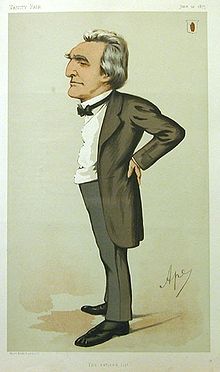Sir John Dalrymple-Hay, 3rd Baronet: Difference between revisions
m Robot - Speedily moving category Members of the United Kingdom Parliament for Scottish constituencies to Category:Members of the Parliament of the United Kingdom for Scottish constituencies per CFDS. |
removed Category:Scottish politicians -- already in subcat Category:Members of the Parliament of the United Kingdom for Scottish constituencies |
||
| Line 96: | Line 96: | ||
[[Category:Members of the Privy Council of the United Kingdom]] |
[[Category:Members of the Privy Council of the United Kingdom]] |
||
[[Category:Royal Navy admirals]] |
[[Category:Royal Navy admirals]] |
||
[[Category:Scottish politicians]] |
|||
[[Category:Scottish admirals]] |
[[Category:Scottish admirals]] |
||
[[Category:Conservative Party (UK) MPs]] |
[[Category:Conservative Party (UK) MPs]] |
||
Revision as of 08:03, 11 June 2015
Sir John Dalrymple-Hay, 3rd Baronet | |
|---|---|
 | |
| Born | 11 February 1821 Wigtown, Wigtownshire, Scotland |
| Died | 28 January 1912 (aged 90) London, England |
| Allegiance | |
| Service/ | |
| Rank | Admiral |
| Commands held | HMS Victory HMS Hannibal HMS Indus |
| Battles/wars | Sixth Xhosa War Oriental Crisis Crimean War |
| Awards | Knight Grand Cross of the Order of the Bath |
Admiral Sir John Charles Dalrymple-Hay, 3rd Baronet GCB (11 February 1821 – 28 January 1912) was a Royal Navy officer and politician. He succeeded to the Baronetcy on 19 March 1861 and was made a Privy Counsellor in 1874.
Naval career
Born in Edinburgh, Hay-Dalrymple was the only child of Sir James Dalrymple Hay, 2nd Baronet, by his first wife Elizabeth, daughter of Lieutenant-General Sir John Shaw Heron-Maxwell, 4th Baronet.[1] His mother died in childbirth. His father remarried in 1823 and had a further eight children. He was educated at Rugby School and entered the Royal Navy in 1834.[2] During his naval career he was involved in the Sixth Xhosa War in South Africa and the Oriental Crisis in Syria,[1] being present when Beirut and St Jean d'Acre fell. He was also concerned with successful operations against Chinese pirates in the 1840s. He commanded HMS Victory from 1854 and then commanded HMS Hannibal during the Crimean War[2] and was decorated by the British and Turkish governments. He was promoted to captain in 1850 and commanded HMS Indus from 1856.[2] He was promoted to rear admiral in 1866, before retiring as an admiral in March 1878.[2] He was Fourth Naval Lord from 1866 to 1868.[2]
Dalrymple-Hay was a Conservative politician. He served as Member of Parliament (MP) for Wakefield 1862-1865.[1] He lost an election at Tiverton on 28 February 1866. He represented Stamford 1866-1880.[1] In 1880-1885 Admiral Hay was the MP for Wigtown Burghs.[1]
Dalrymple-Hay married the Hon. Eliza, daughter of William John Napier, 9th Lord Napier of Merchistoun, in 1847.[1] They had three sons and six daughters.[1] Lady Dalrymple-Hay died in 1901. Dalrymple-Hay survived her by eleven years and died in January 1912, aged 90. He was succeeded in the baronetcy by his second but eldest surviving son, William.
References
- M. Stenton, ed. (1976). Who's Who of British Members of Parliament, Volume I 1832-1885. The Harvester Press.
- Leigh Rayment's list of baronets
- Leigh Rayment's Historical List of MPs
External links
- Use dmy dates from March 2012
- 1821 births
- 1912 deaths
- Anglo-Scots
- Baronets in the Baronetage of Great Britain
- People from Edinburgh
- Knights Grand Cross of the Order of the Bath
- Lords of the Admiralty
- Members of the Privy Council of the United Kingdom
- Royal Navy admirals
- Scottish admirals
- Conservative Party (UK) MPs
- Royal Navy personnel of the Crimean War
- Members of the Parliament of the United Kingdom for English constituencies
- Members of the Parliament of the United Kingdom for Scottish constituencies
- UK MPs 1859–65
- UK MPs 1865–68
- UK MPs 1868–74
- UK MPs 1874–80
- UK MPs 1880–85
- Royal Navy personnel of the Egyptian–Ottoman War (1839–41)
- Fellows of the Royal Society
- Politics of Wakefield
